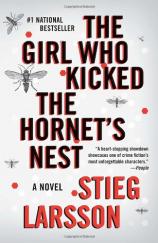The Girl Who Kicked the Hornet's Nest
Review
The Girl Who Kicked the Hornet's Nest
For the moment, THE GIRL WHO KICKED THE HORNET’S NEST is the final volume in what has become known as The Millennium Trilogy. Originally intended as the third of at least a 10-volume series, this is the late Stieg Larsson’s final complete work. Clocking in at 576 pages, the book is dense, convoluted, complicated, and yes, wonderful in every conceivable way. Wrapping up virtually every dangling plotline from the previous two installments, it provides a definite and definitive ending to a series for which its author and the story behind him have become almost as popular and controversial as the novels themselves.
A warning here: if you have not read THE GIRL WITH THE DRAGON TATTOO and THE GIRL WHO PLAYED WITH FIRE, you are going to be extremely confused by the first 100 pages or so of THE GIRL WHO KICKED THE HORNET’S NEST. Larsson doles out his recaps in a piecemeal fashion, going full bore into what is happening in the story’s present while at the same time introducing new characters and providing new historical revelations as to why people are behaving as they are. Then there are those Swedish names. If you wonder why the alphabet has 26 letters, it is so there will be enough of them to spell Swedish names. Truly.
Although the beginning is slow, it is worth every minute it takes to read every sentence because the remainder of the novel easily can be completed in one sitting. Complicated as it is, the plot can be summed up in one hyphenated word: cover-up. The book begins with Lisbeth Salander (The Girl) hospitalized with a bullet in her head following the conclusion of THE GIRL WHO PLAYED WITH FIRE. Zalachenko, Salander’s father and the man who she hates more than anyone in the world, is in a hospital bed a few short steps from her, grievously wounded from Salander’s previous attack. Niedermann, Salander’s brother, is on a murderous rampage through the Swedish countryside. And Mikael Blomkvist, chief investigative reporter for Millennium magazine and Salander’s protector in spite of herself, is under arrest. Even as Salander’s life hangs in the balance, a mysterious, closely held, quasi-official agency known to very few as The Section plots to ensure that, if Salander recovers from her grievous injuries, she will never see the outside of an institution again.
A great deal of HORNET’S NEST concerns the how and, perhaps as importantly, the why of what was done to Salander in her childhood. The majority of the work, however, focuses on Blomkvist’s dogged investigation into Salander’s persecution, which in turn leads to Blomkvist’s gradual discovery and uncovering of The Section. His efforts do not go unnoticed by The Section, and what follows is as complex, fascinating and dangerous a game of cat-and-mouse as you are likely to encounter in contemporary genre fiction. Blomkvist is a brilliant and dangerous adversary, but The Section is willing to stop at nothing to prevent him from revealing what he knows through Millennium, or to keep Salander --- should she survive --- under wraps. And, lest we forget, Niedermann, the personification of every nightmarish Scandinavian fairy tale, is on the loose as well.
Before he died, Larsson reportedly had started a fourth volume and outlined an additional six books. It is doubtful that any of those will see the light of day in any form. What we have from him now, in any event, is a stunning, multi-leveled work, full of complex plots and unforgettable characters, both of which will stay with you long after you read the final words of THE GIRL WHO KICKED THE HORNET’S NEST. It is a fitting and worthy ending to a tale against which many future works in the genre will be judged.
Reviewed by Joe Hartlaub on January 22, 2011










